The Inner World – Review
by Stu
|
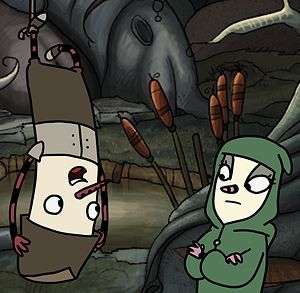 The Inner World is a traditional point-and-click adventure from Studio Fizbin which takes place in the world of Asposia, a hollow space surrounded by endless soil, where the people are fed air through giant wind fountains. Unfortunately, the fountains have dried up and air has become scarce, and on top of that giant monsters called Basylians will turn those who angered the wind gods to stone with their petrifying gaze. Fun times!
The Inner World is a traditional point-and-click adventure from Studio Fizbin which takes place in the world of Asposia, a hollow space surrounded by endless soil, where the people are fed air through giant wind fountains. Unfortunately, the fountains have dried up and air has become scarce, and on top of that giant monsters called Basylians will turn those who angered the wind gods to stone with their petrifying gaze. Fun times!
Your role in The Inner World is to play as Robert, a sheltered teenage Asposian taken in as a child and raised by the guardian of the final functioning wind fountain. Throughout the game, numerous references are made to the lack of outside interaction Robert had with the larger world of Asposia. An incident involving a pigeon with kleptomaniac tendencies sees Robert accidentally ejected outside of the building in which he’d spent his life, and it is here where you pick up the controls and the adventure begins.
As with most point-and-click adventures, guiding Robert through the world of Asposia is handled by clicking to move around the screen and this, in larger areas, will also cause the scene to pan. Clicking on hotspots will pop-up bubbles to indicate the actions available: magnifying glass for inspection, cogs for interaction with other objects, a hand for using objects, and a speech bubble for conversation. Holding down the mouse button activates the standard ‘show all hotspots’ mechanic where any in your current area will be highlighted.
The inventory appears as you mouse to the bottom of the screen and uses a basic drag and drop system for use. The icons are both clear and obvious, great for anyone using a larger screen or running in high resolutions. As with most adventure games of this ilk, interaction between objects in the inventory is a common occurrence and a requirement to solve many of the puzzles laid before Robert. Each item in the inventory can also be clicked to generate two more icon bubbles – one for inspection and the other to use the object.
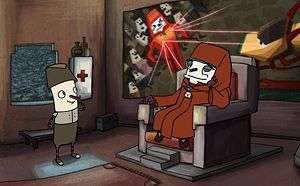 The puzzle element of the game is not overly taxing for the most part but, on occasion, may have you scratching your head trying to work out what you need to do next. Thankfully, Studio Fizbin have added an optional hints system that can be accessed by mousing to the top of the screen. The hints system starts quite subtly and gets progressively more obvious as you click for the next pointer, which is a great way of handling hints. Just enough to give you a nudge in the right direction without solving it for those who need a little help but also covers those who may need a walkthrough for a particularly trying puzzle.
The puzzle element of the game is not overly taxing for the most part but, on occasion, may have you scratching your head trying to work out what you need to do next. Thankfully, Studio Fizbin have added an optional hints system that can be accessed by mousing to the top of the screen. The hints system starts quite subtly and gets progressively more obvious as you click for the next pointer, which is a great way of handling hints. Just enough to give you a nudge in the right direction without solving it for those who need a little help but also covers those who may need a walkthrough for a particularly trying puzzle.
The storyline progresses smoothly and keeps the player engaged, although some points are unnecessarily dragged out by lots of walking back and forth to solve puzzles. Humour and the obvious naivety of Robert versus the savvy lone-wolf attitude of Laura plays a major part in keeping what is essentially a dark story light and enjoyable. Unfortunately the game is let down a little by some of the voice acting, and whether this is due to poor translation (Studio Fizbin are based in Germany) or untested talent, I could not say, but I tried the German version briefly and the voice of Robert is hugely different between the two. The actors portraying Conroy and Laura give a great performance, however multiple words changed pronunciation throughout the game, sarcasm or other vocal inflections were sometimes missing and, at times, a sentence in a conversation would go missing where the subtitles still appeared but no audio accompanied them.
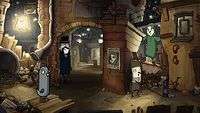 |
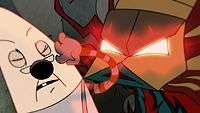 |
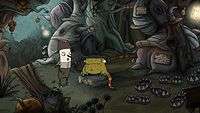 |
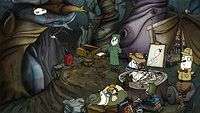 |
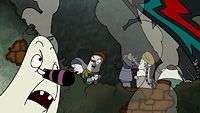 |
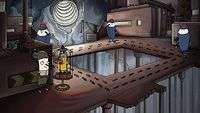 |
There was also one point where a cut-scene had German language signs but then switched back to English for the playable section. It seemed that translation and handling of localisation didn’t end up with the best possible outcome which means that, due to audio dialogue issues, you often find yourself taken out the game to mentally query the way a character said something.
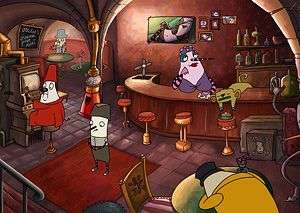 That isn’t to say the audio is all bad, as the soundtrack that accompanies the game is perfect background music for a game of this type and with each area of the game having its own unique backing track, the ambient music doesn’t get stale. A section in a bar has a relaxed vibe with deep, slow strings, and light cymbal percussion making up the beat while another area has a soundtrack that has many hallmarks of the Dexter TV series’ theme tune with piano, woodblocks, and strings. Studio Fizbin found a great composer to work with as the soundtrack matches the areas well without intruding on the game or becoming an irritating, looping noise. Along with the fantastic background art, the soundtrack is one of the games major high points.
That isn’t to say the audio is all bad, as the soundtrack that accompanies the game is perfect background music for a game of this type and with each area of the game having its own unique backing track, the ambient music doesn’t get stale. A section in a bar has a relaxed vibe with deep, slow strings, and light cymbal percussion making up the beat while another area has a soundtrack that has many hallmarks of the Dexter TV series’ theme tune with piano, woodblocks, and strings. Studio Fizbin found a great composer to work with as the soundtrack matches the areas well without intruding on the game or becoming an irritating, looping noise. Along with the fantastic background art, the soundtrack is one of the games major high points.
The graphical take on The Inner World is a beautiful one. The background art seems hand-drawn with plenty of detail, shading and colour with foreground characters being colourful, cartoony and simple. The people of Asposia are brought to life by their distinctive striped noses, arms and legs. Animation of characters is smooth and even when not doing anything other characters on screen will fidget and not remain as still as stone. Every location has had care and attention paid to it, and nothing about the artwork seems rushed or half-done.
The overall adventures of Robert and Laura didn’t last as long as I had expected, but you can expect a good five to eight hours of entertainment from it (depending on skipping repeated animations, use of hints, etc). It was good to reach the end of the game wanting more, with The Inner World doing anything but overstaying its welcome. As with most games of this nature, most of the mystery is in the story and the puzzles so playing through more than once may not appeal to those who know will no longer have the challenge.
Pros- Beautiful artwork
- Great soundtrack
- Rock solid traditional point-and-click adventure
- Superb hints implementation
- Localisation issues with language/voice acting
- Fairly short for an adventure game
Fans of point-and-click adventures are unlikely to find anything new, but The Inner World provides a fun adventure that doesn’t need any genre-changing features to enjoy. Despite the few issues with sentences missing audio and a couple of localisation oddities the overall quality of the game overshadows those minor negatives. Enhancements to the usual hints system provides an extra incentive for anyone thinking of dipping their toes into the point-and-click genre or for those who find themselves reaching for internet guides, but the overall difficulty may be a little on the easy side for veterans who like a tough intellectual challenge from puzzles.
Anyone who appreciates the art or soundtracks should definitely give this a whirl as they are far and above the highlights of the game, but anyone looking for a stiff challenge or a lengthy adventure may feel a bit let down. With a world as unique as Asposia, it’s a shame there wasn’t more information to be found about the world in which Robert and Laura live and, if anything, the game concentrated too much on the core story and getting through it that it forgot to add in fringe information to help better cement the player inside the game. The Inner World is a great game for a no fuss point-and-click adventure, let down only by minor glitches and a feeling that it could have been just a little more fleshed out with lore and background information.
Last five articles by Stu
- When A Choice Isn't Really A Choice At All
- Best of 2013: Next-Gen: #Fail
- Deadfall Adventures - Review
- Assassin's Creed IV: Black Flag - Review
- The Inner World - Review

















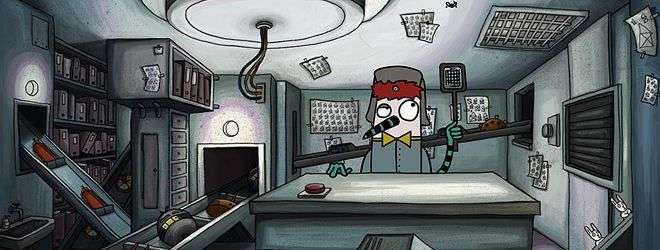
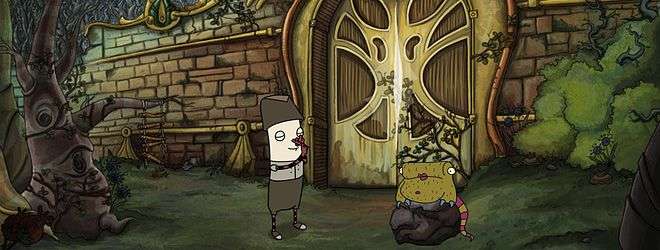






There are no comments, yet.
Why don’t you be the first? Come on, you know you want to!